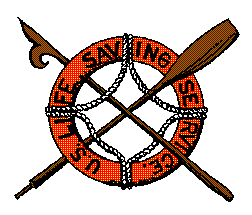
Klipsan Beach Life Saving Station
Encyclopedia

United States Life-Saving Service
The United States Life-Saving Service was a United States government agency that grew out of private and local humanitarian efforts to save the lives of shipwrecked mariners and passengers...
. The station buildings still remain, although they are privately owned. The station is on the National Register of Historic Places
National Register of Historic Places
The National Register of Historic Places is the United States government's official list of districts, sites, buildings, structures, and objects deemed worthy of preservation...
. The station's name was originally Ilwaco
Ilwaco, Washington
Ilwaco is a city in Pacific County, Washington, United States. The population was 950 at the 2000 census and decreased to 936 at the 2010 census.-History:...
Beach, and only later became known as Klipsan Station. The station was one of several assigned to protect the area known as the Graveyard of the Pacific
Graveyard of the Pacific
The Graveyard of the Pacific is a nickname for a stretch of the coastal region in the Pacific Northwest, from Tillamook Bay on the Oregon Coast northward to the tip of Vancouver Island...
.
Location
On the Long Beach PeninsulaLong Beach Peninsula
The Long Beach Peninsula is an arm of land in western Washington state. It is bounded on the west by the Pacific Ocean, the south by the Columbia River, and the east by Willapa Bay...
, in Pacific County, Washington, about 13 miles (21 km) north of Cape Disappointment
Cape Disappointment (Washington)
Cape Disappointment is a headland located at the extreme southwestern corner of Washington State on the north side of the Columbia River bar, at . The point of the cape is located on the Pacific Ocean in Pacific County, approximately two miles southwest of the town of Ilwaco...
.
Construction and architecture
The station was established in 1891. It was built according to the "Marquette" style of life-saving stations, one of a number of standard station designs adopted by the United States Life-Saving ServiceUnited States Life-Saving Service
The United States Life-Saving Service was a United States government agency that grew out of private and local humanitarian efforts to save the lives of shipwrecked mariners and passengers...
. This pattern received its name from the station where it was first used, Marquette, Michigan
Marquette, Michigan
Marquette is a city in the U.S. state of Michigan and the county seat of Marquette County. The population was 21,355 at the 2010 census, making it the most populated city of the Upper Peninsula. Marquette is a major port on Lake Superior, primarily for shipping iron ore and is the home of Northern...
. There were 13 other life-saving Marquette stations, their architect was Albert B. Bibb, and it is speculated that the plans were drawn up in 1889. Other Marquette stations on the West Coast
West Coast of the United States
West Coast or Pacific Coast are terms for the westernmost coastal states of the United States. The term most often refers to the states of California, Oregon, and Washington. Although not part of the contiguous United States, Alaska and Hawaii do border the Pacific Ocean but can't be included in...
include those at Yaquina Bay
Yaquina Bay
Yaquina Bay is a small bay partially within Newport, Oregon, United States, located where the Yaquina River flows into the Pacific Ocean. It is traversed by the Yaquina Bay Bridge. The bay's area is about 8 km² .-See also:...
, the Umpqua River
Umpqua River
The Umpqua River on the Pacific coast of Oregon in the United States is approximately long. One of the principal rivers of the Oregon Coast and known for bass and shad, the river drains an expansive network of valleys in the mountains west of the Cascade Range and south of the Willamette Valley,...
, Coos Bay
Coos Bay
Coos Bay is an S-shaped inlet where the Coos River enters the Pacific Ocean, approximately 10 miles long and two miles wide, on the Pacific Ocean coast of southwestern Oregon in the United States. The estuary is situated south of the Salmon River. The city of Coos Bay, once named Marshfield, was...
, and the Coquille River
Coquille River
The Coquille River is a stream long, in southwestern Oregon in the United States. It drains a mountainous area of of the Southern Oregon Coast Range into the Pacific Ocean. Its watershed is located between that of the Coos River to the north and the Rogue River to the south.-Geography:The river,...
in Oregon
Oregon
Oregon is a state in the Pacific Northwest region of the United States. It is located on the Pacific coast, with Washington to the north, California to the south, Nevada on the southeast and Idaho to the east. The Columbia and Snake rivers delineate much of Oregon's northern and eastern...
and at Southside, California.
The boat house was also built according a standard United States Life-Saving Service
United States Life-Saving Service
The United States Life-Saving Service was a United States government agency that grew out of private and local humanitarian efforts to save the lives of shipwrecked mariners and passengers...
plan, called the "witch's hat" for the design's use of a distinct octagonal ventilator with a conical roof.
Volunteer operations
The station was first started in 1889 on a volunteer basis, and called the Ilwaco Beach station. On November 3, 1891, the ship Strathblane went aground near the station. The volunteer crew was unable to get their lines out to the ship, and seven people died. As a result of this, a decision was made to put the station on a full-time professional basis.Professional keepers
Richard Turk was appointed keeper on December 18, 1891 and died on December 2, 1894. William S. Lawrence was appointed keeper on January 4, 1895 and "services dispensed with" on October 9, 1897. George Jorgensen was appointed keeper on November 17, 1897 and transferred to Point Reyes on February 7, 1902. Theodore Conick was appointed keeper on that date and was still serving in 1915. Chief Warrant Officer Joseph Henderson was listed as the Chief Officer in 1929.Equipment
The station was equipped with a Dobbins type lifeboat and a McClelland surfboat, which were launched into the surf from a four-wheel hand or horse-drawn carriage. The station was also equipped with a variety of rescue equipment, including the Lyle gun, the breeches buoy, and Coston flares. At times, surfmen rode horses to patrol the beaches The station could call upon the assistance of a seaside railroad, the Ilwaco Railway and Navigation CompanyIlwaco Railway and Navigation Company
The Ilwaco Railway and Navigation Company operated a narrow gauge railroad ran for over forty years from the bar of the Columbia River up the Long Beach Peninsula to Nahcotta, Washington, on Willapa Bay. The line ran entirely in Pacific County, Washington, and had no connection to any outside rail...
, to move rescue boats up and down the beach to get closer to a wreck before launching.
Use of railroad
The Ilwaco Railway and Navigation CompanyIlwaco Railway and Navigation Company
The Ilwaco Railway and Navigation Company operated a narrow gauge railroad ran for over forty years from the bar of the Columbia River up the Long Beach Peninsula to Nahcotta, Washington, on Willapa Bay. The line ran entirely in Pacific County, Washington, and had no connection to any outside rail...
railroad also took the crew of the station to wherever a vessel might have stranded on the beach along the line. Occasional special runs were made to bring on-lookers to a wreck site, and weekly excursions were made to take vacationers to watch the lifeboat rescue drills at the Klipsan Beach Station. L.A. Loomis was closely involved with the establishment of the life-saving station near to the railway line, which ran along the eastern boundary of the proposed station property. Loomis promised a siding along the northern boundary to the boathouse overlooking the ocean. A flatcar was placed there to allow transport of rescue crews and boats to points along the beach.
The railroad was used in at least one rescue, on December 19, 1896, when the German bark Potrimpos drifted ashore seven miles south of the life-saving station. The horse-drawn lifeboat was not able to get down the beach, but the railroad transported a life boat and crew to the scene of the wreck, where fourteen men were still aboard. The lifeboat was launched, and all the men were saved. A special train also brought up the life-saving crew from the next south station, Cape Disappointment, but by the time they arrive, all the men had been taken off the stricken bark.
The tracks were so close to the life-saving station that surfmen and their children could and did pose for photographs on the crude platform at the station, with the rails in foreground and the station clearly shown in the background.
- Wreck of the Alice, with Klipsan Beach life-saving crew launching boat in surf
- Ilwaco (later Klipsan Beach) Life Saving Station, circa 1895
- wreck of the Potrimpos
Wrecks along the North Beach
A partial listing of wrecks along the North Beach (that is, the ocean side of the Long Beach PeninsulaLong Beach Peninsula
The Long Beach Peninsula is an arm of land in western Washington state. It is bounded on the west by the Pacific Ocean, the south by the Columbia River, and the east by Willapa Bay...
) during the station's operation includes, running from north to south on the beach:
- schoonerSchoonerA schooner is a type of sailing vessel characterized by the use of fore-and-aft sails on two or more masts with the forward mast being no taller than the rear masts....
Solano, February 5, 1907 - Glenmorag, March 19, 1896
- Caoba, February 5, 1925
- barkBarqueA barque, barc, or bark is a type of sailing vessel with three or more masts.- History of the term :The word barque appears to have come from the Greek word baris, a term for an Egyptian boat. This entered Latin as barca, which gave rise to the Italian barca, Spanish barco, and the French barge and...
Alfa, September 19, 1924 - Alice, January 15, 1909
- Lenore, April 10, 1917
- Strathblane, November 3, 1891
- Artemsia, 1889
- C.A. Klose (or Close), March 26, 1905
- barkBarqueA barque, barc, or bark is a type of sailing vessel with three or more masts.- History of the term :The word barque appears to have come from the Greek word baris, a term for an Egyptian boat. This entered Latin as barca, which gave rise to the Italian barca, Spanish barco, and the French barge and...
Potrimpos, December 19, 1896 - steamer Point Loma, February 28, 1896
- schoonerSchoonerA schooner is a type of sailing vessel characterized by the use of fore-and-aft sails on two or more masts with the forward mast being no taller than the rear masts....
Frank W. Howe, February 22, 1904
The station now
The station is no longer on the beach, which has receded a long way since active operations ceased. A photo from the beach when the station was active shows the beach extending to the station's watchtower and boat house. This is no longer the case. The station itself, as well as the boathouse and watchtower remained as of 2000, and were in private ownership.External links
- The Official Klipsan Beach Life Saving Station Website
- U.S. Coast Guard Historian's Office
- The Sou'Wester, Journal of the Pacific County Historical Society, Volume 36, No. 3 (Fall, 2001), covering details of Klipsan Beach station and other life-saving stations, including equipment, history, and drills

